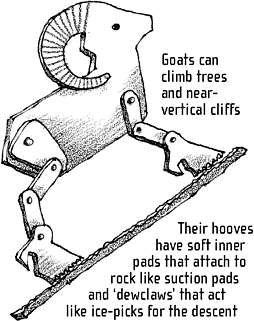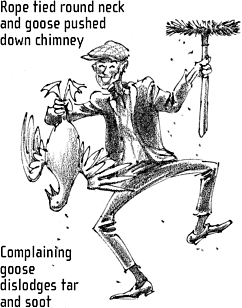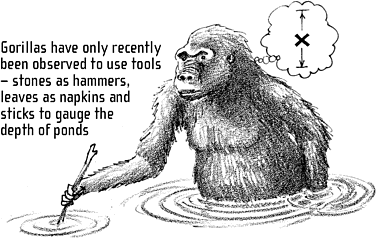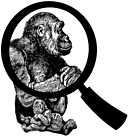The Book of Animal Ignorance (16 page)
Read The Book of Animal Ignorance Online
Authors: Ted Dewan
F
ar from being a poor relation of sheep and cattle, the goat (
Capra hircus
) was the first herbivore to be domesticated, 10,000 years ago in the mountains of Iran. Without goats, agriculture might never have taken off. The bezoar or wild goat (
Capra aegagrus
), ancestor of all domestic breeds, seduced the Neolithic nomads with its hardiness, its âherdability', and its weed-busting diet. Goats, then as now, much prefer thistles, brambles and twigs to plain grass (a grass-fed goat suffers badly from worms). It was an unbeatable combination and as the first farmers radiated outwards from the Middle East, the goats followed as a kind of all-terrain convenience store, every bit as revolutionary in their time as seed-drills or combine-harvesters.
In developing countries, goats are still a very important economic resource. They produce more milk for their size than cows and some estimates put goat ahead of chicken and pork as the world's most consumed meat. Even in the US, goat is now the fastest-growing livestock sector. The meat is healthy, with much less fat and cholesterol and more iron than lamb or beef. Goat's milk has more protein and calcium, and less lactose than cow's milk. They also make good pets, and are surprisingly fastidious. If another goat's saliva has touched their food, or if it has even the faintest taint of dirt, they will refuse to eat it.
The word âtragedy'
comes from ancient
Greek and means
âgoat-
song'
.
The only downside is the smell. âGoatiness' comes from a trio of fatty acids present in both the milk and the meat. These are also produced as waste products by the ten million or so bacteria that feed in the human armpit, which might explain our squeamishness. Female goats on heat, however, find it irresistible.
Goats have a reputation for lust and excess which has a sound
basis in fact. A male goat (buck or billy) is ready for action at just four months. As he comes into ârut', he begins to smell strongly â this is not helped by a fondness for urinating along his belly and soaking his beard. To really get in the mood, he will lick his penis and then drink the urine of his prospective partners. The nannies (or does) either stand back and watch until they are needed, or mount one another to further inflame his ardour.
In Sudan in 2006, a
man caught having
sex with his
neighbour's goat
was forced to marry
it and pay a dowry
to its former owner
.
SPIDERGOA

The manâgoat relationship can be equally close. Alexander Selkirk, the castaway who was the real-life model for
Robinson
Crusoe
, used to mark the ears of the goats he âenjoyed most' so as to avoid eating them. The ancient Gauls made goat's milk hair-cream. For a thousand years, the sum of human knowledge was recorded on goatskin parchment. Young goat's leather made soft gloves (hence the expression âhandle with kid gloves') and the hair from their backs gave us cashmere, the fashionable yarn for ladies; its name is an old spelling of Kashmir, the region where the longhaired goats come from. In 2002 a herd of Canadian goats was implanted with a single spider gene. When their milk was skimmed and the protein extracted it made a fibre that was identical to spider silk. It has been patented as BioSteel.
Goats have a much greater mythological resonance than sheep or cattle. The horn of plenty belonged to a goat. Pan and Satan had goat's legs and horns, and in Hindu mythology
aja
means both âgoat' and the primordial nothingness from which everything came.
D
espite having acquired a reputation for stupidity, geese show signs of great sensitivity and intelligence. Many species mate for life and the death of a loved one leads to behaviour that is remarkably similar to our own. They honk mournfully, stop eating, hunch up their feathers and can remain that way for months. If one is shot down, its partner will return to earth to stand vigil next to its corpse. Reunited couples perform a âtriumph ceremony' â a combination of dance and song which re-enacts their courtship. Geese can even be taught to perform simple tasks â there are several nineteenth-century accounts of them turning spits, using their powerful necks like an arm.
THE CHIMNEY SWEEP'S GOOSE

The French ornithologist Christian Moullec has taught a group of thirty endangered Lesser white-fronted Geese (
Anser
erythropus
) a new migratory path. After bonding with them as goslings, he flew a microlight to lead them the 1,000 miles between wildlife sanctuaries in Germany and Sweden, a journey they repeated the following year on their own. They are now so well trained that Moullec and his âflock' regularly appear as the star turn at airshows.
Although farmyard geese rarely fly, the wild birds are amazing long-distance aviators. Six million Lesser snow geese (
Chen caerulescens caerulescens
) travel the 4,000 miles from the Arctic to the Gulf of Mexico twice a year. The
Barheaded goose (
Anser indicus
) migrates from Central Asia to India over the Himalayas at a height of 29,000 feet. The swirl of air created by flying in V-formation produces more lift and a clearer view for each bird. They lose altitude by whiffling â a spiralling nosedive, which sometimes leaves them flying upside down.
People wrote with goose
quills until the nineteenth
century. âPen' comes from the
Latin âpenna', or âfeather'.
Quink, the world's top selling
ink, is also an old name for
the Brent goose
.
Geese were domesticated about 3,000 years ago in ancient Egypt from the wild Greylag goose (
lag
is an old word for âgoose', so we should really just call them greylags). It had more to do with sex than food. Wild greylags were the focus of fertility cults throughout the ancient world and goose fat was considered a powerful aphrodisiac. The famous geese on the Capitoline Hill, who saved Rome from the Gauls in 390
BC
, were being kept as sexual talismans not âguard dogs'.
The connection is still alive in the innuendo of the nursery rhyme âGoosey, goosey, gander' and for centuries
goose
was slang for a prostitute while
gooser
meant penis. The verb âto goose' still carries a sexual connotation.
Because no one ever saw a migratory goose mate or lay an egg, for centuries it was thought they hatched from the barnacles washed ashore on driftwood at the same time of year as they arrived from the Arctic. This belief persisted well into the days when scientists were naming species; thus today we have the Barnacle goose (
Branta leucopsis
) and the Goose barnacle (
Lepas
anatifera
).
It caused confusion for the Catholic Church, too. Some dioceses allowed the eating of geese on fast days because they were âfish', others because they were ânot born of the flesh', and therefore a kind of vegetable or nut. Pope Innocent III finally banned goose-eating on fast days in 1215.
G
orillas are the largest living primates and the most misunderstood. Their name dates to 480
BC
when the Carthaginian explorer Hanno described an African tribe of âhairy women'. He called them
Gorillai
and it was this that American missionary Dr Thomas Savage decided to use to describe the âmonkey-like animal remarkable for its size and ferocity' whose skull he'd seen when he visited the Congo in 1847. In the popular imagination, Savage's gorilla came to personify animals at their most wild and terrifying, a myth that culminated in the 1933 film
King Kong
.
Real gorillas are shy and peaceful creatures. They are herbivores, eating green plants and bark. To run a 25-stone male gorilla requires a straw bale's weight in vegetation every day, which is why they have such huge stomachs (to house the large intestinal tract) and heads (to anchor the huge jaw muscles needed for chewing). It also explains their habit of eating their own droppings; as with rabbits, this helps them extract the maximum nutrition and re-cycle helpful digestive bacteria and enzymes. Also, because leafy plants are low in sodium, gorillas supplement their green diet with tasty mouthfuls of soil.
Both species of Gorilla, western (
G. gorilla
) and eastern (
G.
beringei
), live in the equatorial forests of Africa where vegetation is both plentiful and fast growing. This enables them to maintain much smaller ranges than their cousins, the fruit-seeking chimps. The consequence of this is a âharem' system where a dominant âsilverback' male lives with up to ten females and youngsters. All a single lady gorilla wants is a large, powerful male with a good-quality home range. As a result, silverbacks are much bigger than the females, but sex isn't at such a premium as among the promiscuous chimps â a silverback's erect penis is only an inch and a half long. He doesn't need to compete sexually once he's got his troop: they do what he says. At least
they do until a younger male chances his arm. This is where the âscary ape' routine derives from: standing tall, drumming chests with cupped hands, yawning to display canine teeth, roaring and charging. Actual fighting is rare; as with humans, loud threats backed up by size usually carry the day.
Despite this, gorillas are the strong, silent members of the ape family. They aren't as vocal or as flashy with their skills as chimps, but they have better memories and often do things independently rather than simply for a reward. Koko, a female gorilla born at San Francisco Zoo in 1971, has mastered up to a thousand words in sign language, and seems able to communicate complex emotions like sadness and even make jokes. She describes herself, touchingly, as âfine animal person gorilla'.
The Beast was a tough
guy too. He could lick
the world. But when he
saw Beauty, she got
him. He went soft. He
forgot his wisdom and
the little fellas licked
him
.
KING KONG
FORWARD PLANNING

It's hard to know how much of Koko's âpersonhood' derives from the thirty years she has spent being coached (and loved) by developmental psychologist Dr Penny Patterson. Ironically, it was just this ability to bond with a human that spelt doom for Kong in the film. Given the precarious position of the gorilla population (10,000 western gorillas and only 400 of the mountain species), maybe Koko's willingness to learn and talk in our language, will persuade us to rewrite
King Kong
's tragic ending and preserve her relatives in the wild, where they are happiest.


